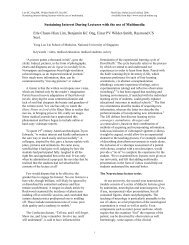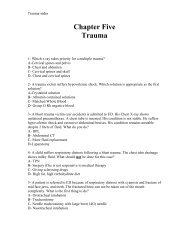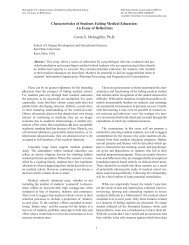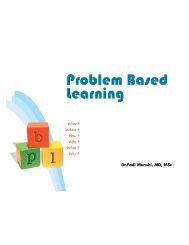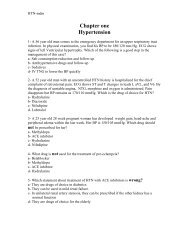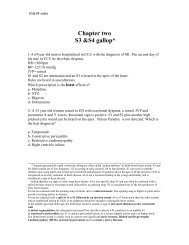policy analysis in medical education: a structured approach
policy analysis in medical education: a structured approach
policy analysis in medical education: a structured approach
You also want an ePaper? Increase the reach of your titles
YUMPU automatically turns print PDFs into web optimized ePapers that Google loves.
Musick DW. Policy <strong>analysis</strong> <strong>in</strong> <strong>medical</strong> <strong>education</strong>:A <strong>structured</strong> <strong>approach</strong>.Med Educ Onl<strong>in</strong>e [serial onl<strong>in</strong>e] 1998;3,2. Availablefrom URL http://www.utmb.edu/meo/SynthesisRepresentative of the field of <strong>education</strong>al<strong>policy</strong> <strong>analysis</strong> as a dist<strong>in</strong>ct discipl<strong>in</strong>e is thework of Carol Weiss. 21,22 Accord<strong>in</strong>g to Weiss,much of what passes for <strong>policy</strong> <strong>analysis</strong> and discourseis adapted from the social sciences. Conceptsfrom the social sciences, such as professionalnorms, organizational culture, social network<strong>in</strong>g,and bureaucratic/political structures,are “borrowed” and applied to other (e.g. <strong>education</strong>al)realms. This, <strong>in</strong> turn, helps to disguisethe fact that: “much of what <strong>policy</strong> makers knowcomes from disparate, unorganized and <strong>in</strong>choateexperience…social science concepts give formto this tacit knowledge and enable <strong>policy</strong> makersto manipulate and use it”.Weiss further states that <strong>policy</strong> is the productof <strong>in</strong>terplay among four essential components,the “four ‘I’s” of <strong>policy</strong> <strong>analysis</strong>: <strong>in</strong>stitution,<strong>in</strong>formation, ideology, and <strong>in</strong>terests. To elaborate,<strong>policy</strong> decisions are made with<strong>in</strong> given<strong>education</strong>al <strong>in</strong>stitutions. The process of <strong>policy</strong>formation and implementation results from acomb<strong>in</strong>ation of rational <strong>in</strong>formation-process<strong>in</strong>g,ideologies of various k<strong>in</strong>ds, and the <strong>in</strong>terests ofself and/or others who may be affected by thepolicies. Weiss’ <strong>approach</strong> is useful <strong>in</strong> understand<strong>in</strong>gcontextual factors which affect <strong>policy</strong>development, but does not provide an overallframework for <strong>policy</strong> <strong>analysis</strong>.Short 24 has described an <strong>approach</strong> to <strong>policy</strong><strong>analysis</strong> <strong>in</strong> <strong>education</strong> which is research-oriented.He outl<strong>in</strong>es ten methods of <strong>in</strong>quiry currently <strong>in</strong>use with<strong>in</strong> the field of curriculum studies, anddescribes their use <strong>in</strong> analyz<strong>in</strong>g <strong>education</strong>al researchand evaluation. These ten methods are:philosophical, historical, scientific, artistic,moral, religious, <strong>in</strong>terpretive, <strong>in</strong>strumental, deliberativeand action-oriented. These dist<strong>in</strong>ctionsare useful <strong>in</strong> terms of help<strong>in</strong>g <strong>medical</strong> educatorsunderstand the various aspects of <strong>policy</strong><strong>analysis</strong> and how they might relate to <strong>medical</strong><strong>education</strong> <strong>policy</strong>.Humes 4 exam<strong>in</strong>es key questions used by <strong>education</strong>aldecision-makers <strong>in</strong> order to understandall aspects of the <strong>policy</strong> <strong>analysis</strong> and developmentprocess. Key questions are: 1) By whatprocesses do new <strong>education</strong>al policies beg<strong>in</strong> tobe formed?; 2) How are these processes <strong>in</strong>fluencedby ideological, political, economic, andcultural concerns?; 3) Who has the most <strong>in</strong>fluence<strong>in</strong> the formation of new <strong>education</strong>al policies(i.e., politicians, bureaucrats, or teach<strong>in</strong>g professionalswith<strong>in</strong> <strong>education</strong>)?; 4) Where does theresponsibility lie for the success or failure ofnew <strong>education</strong>al policies (i.e., with <strong>policy</strong> makers,managers or teachers)? This author alsostresses the importance of <strong>in</strong>volv<strong>in</strong>g parties fromboth “<strong>in</strong>side” and “outside” the formal <strong>education</strong>algovern<strong>in</strong>g body <strong>in</strong> analyz<strong>in</strong>g new <strong>education</strong>al<strong>policy</strong>.Reid 23 advocates a <strong>structured</strong> <strong>approach</strong> to<strong>education</strong>al <strong>policy</strong> <strong>analysis</strong> which is geared towardcurricular issues. He states that five crucialareas must be considered <strong>in</strong> develop<strong>in</strong>g <strong>education</strong>al/curricularpolicies: teachers, learners, the“<strong>education</strong>al milieu” (or environment), subjectmatter, and “curriculum-mak<strong>in</strong>g” (i.e., <strong>education</strong>aldecision-mak<strong>in</strong>g processes). He lamentsthe “<strong>in</strong>trusion of <strong>in</strong>terests outside the professionalworld of <strong>education</strong>” <strong>in</strong>to <strong>education</strong>al <strong>policy</strong>development, stat<strong>in</strong>g that such <strong>in</strong>trusion hasled to “<strong>approach</strong>es [which] stress top-down controland short-term goals” rather than sound <strong>education</strong>alpolicies.Based on this review, what seems miss<strong>in</strong>gfrom the <strong>medical</strong> <strong>education</strong> literature is a rigorousmethodological <strong>approach</strong> to <strong>policy</strong> <strong>analysis</strong>which can be used with<strong>in</strong> the unique context of<strong>medical</strong> <strong>education</strong>. In short, a “tool” is neededwhich can be used by decision-makers <strong>in</strong> <strong>medical</strong>schools to assist them <strong>in</strong> the process of <strong>policy</strong><strong>analysis</strong>. Such a tool does not appear to exist atpresent.A Specific ExampleA <strong>policy</strong> issue which has been addressedwith<strong>in</strong> the field of <strong>medical</strong> <strong>education</strong> <strong>in</strong> recentyears demonstrates the need for an analytic <strong>approach</strong>to <strong>policy</strong> <strong>analysis</strong>. Debate has been evidencedon issues related to governance structureswith<strong>in</strong> <strong>medical</strong> schools. 24,25 What is often aprimary feature of such debate appears to <strong>in</strong>volvea clash between two diverse views of authority,namely, professional authority and adm<strong>in</strong>istrativeauthority. As stated by Etzioni 26 ,“the most basic pr<strong>in</strong>ciple of adm<strong>in</strong>istrativeauthority and the most basic pr<strong>in</strong>ciple of authoritybased on knowledge (or professional authority)not only are not identical but are quite <strong>in</strong>compatible…theultimate justification for a professionalact is that it is, to the best of the professional’sknowledge, the right act. He might3
Musick DW. Policy <strong>analysis</strong> <strong>in</strong> <strong>medical</strong> <strong>education</strong>:A <strong>structured</strong> <strong>approach</strong>.Med Educ Onl<strong>in</strong>e [serial onl<strong>in</strong>e] 1998;3,2. Availablefrom URL http://www.utmb.edu/meo/sions? Is there a potential or actual conflictof <strong>in</strong>terest?I. Historical: Does the proposed <strong>policy</strong> have ahistory with<strong>in</strong> the <strong>in</strong>stitution? Have previousattempts been made to address the <strong>policy</strong>issue under consideration? If so, whatwas the result? What can be learned fromthese previous attempts?J. Assumptive: Are there key assumptions be<strong>in</strong>gmade by the various parties <strong>in</strong>volved <strong>in</strong>or affected by the <strong>policy</strong> issue? What arethe assumptions made by those on bothsides of the issue? Have these assumptionsbeen made explicit? Are these assumptionsknown and understood by all <strong>policy</strong> decision-makers?K. Legal: What legalities or legal precedentsmay be <strong>in</strong>volved <strong>in</strong> or have an effect on theproposed <strong>policy</strong>? What key legislationand/or other legal requirements are likely tohave an impact on <strong>policy</strong> development?L. Logical: Are statements made <strong>in</strong> the <strong>policy</strong>logically sound? Do they avoid illogical orfaulty <strong>in</strong>ferences? Can they withstand rigorousscrut<strong>in</strong>y by a “neutral” party?It is not assumed that each of the twelvecomponents of <strong>policy</strong> <strong>analysis</strong> would be of equalvalue to a given <strong>policy</strong> discussion. However, itis suggested that an exam<strong>in</strong>ation of all twelvecomponents be considered essential to the processof develop<strong>in</strong>g sound <strong>education</strong>al <strong>policy</strong>.The Use of A Structured Approach to PolicyAnalysisAs an example of how to use this <strong>policy</strong><strong>analysis</strong> tool <strong>in</strong> a <strong>medical</strong> <strong>education</strong> context,consider a familiar issue related to the curriculumof a <strong>medical</strong> school: <strong>medical</strong> ethics <strong>education</strong>.While public <strong>in</strong>terest <strong>in</strong> ethical issueswith<strong>in</strong> medic<strong>in</strong>e and bio<strong>medical</strong> research seemsto be explod<strong>in</strong>g, it is apparent that the time givento this subject <strong>in</strong> most <strong>medical</strong> schools has onlyrecently <strong>in</strong>creased. 29 As a hypothetical <strong>policy</strong><strong>analysis</strong> “case”, suppose the Curriculum Committeeat the “XYZ Medical School” is presentedwith a petition signed by one-third of theschool’s students where<strong>in</strong> a request is made to<strong>in</strong>crease the amount of <strong>medical</strong> ethics <strong>education</strong>with<strong>in</strong> the curriculum, <strong>in</strong>clud<strong>in</strong>g a recommendationthat a separate, identifiable course called“Medical Ethics” be offered. This request representsan op<strong>in</strong>ion that decision-makers at “XYZMedical School” should reexam<strong>in</strong>e and perhapschange an exist<strong>in</strong>g <strong>education</strong>al <strong>policy</strong>. How orby what process should members of the Committeego about consider<strong>in</strong>g this issue?Among the steps the Curriculum Committeeshould take, the use of the twelve <strong>policy</strong> <strong>analysis</strong><strong>in</strong>gredients as discussed previously should be<strong>in</strong>corporated <strong>in</strong>to a formal process of <strong>policy</strong><strong>analysis</strong> and <strong>education</strong>al decision-mak<strong>in</strong>g. So,for example, the Committee would need to ensurethat the follow<strong>in</strong>g general types of <strong>in</strong>formationwere available before a f<strong>in</strong>al decision ismade on whether to <strong>in</strong>crease the amount of curricularcontent <strong>in</strong> <strong>medical</strong> ethics:A. Conceptual: what are the “core concepts”which should be <strong>in</strong>cluded <strong>in</strong> an ethics <strong>education</strong>curriculum for <strong>medical</strong> students?What <strong>education</strong>al outcomes would be measuredto ensure that students learned theseconcepts?B. Normative: is “<strong>medical</strong> ethics” someth<strong>in</strong>gthat ought to be <strong>in</strong>cluded <strong>in</strong> the curriculum?At least some of the <strong>medical</strong> students feelstrongly that it should be; do other constituentgroups (e.g., faculty, adm<strong>in</strong>istration, patients,former students/residents) concur?What about accreditation standards; do theyaddress the issue of ethics <strong>education</strong>? If so,how?C. Theoretical: if a core curriculum <strong>in</strong> ethics isto be adopted, with<strong>in</strong> what theoretical and/ordiscipl<strong>in</strong>ary framework would this materialfit? By what <strong>education</strong>al process(es) shouldthe material be taught to <strong>medical</strong> students?Will such teach<strong>in</strong>g require a separate course,as the students suggest, or can the materialbe <strong>in</strong>tegrated <strong>in</strong>to exist<strong>in</strong>g courses?D. Empirical: what does the <strong>medical</strong> <strong>education</strong>literature reveal on this issue? Are therestudies which show the value of <strong>in</strong>clud<strong>in</strong>gethics <strong>education</strong> <strong>in</strong> the <strong>medical</strong> school curriculum?What has been the experience ofother <strong>medical</strong> schools who have <strong>in</strong>troducedan ethics component <strong>in</strong>to the curriculum?Are the “facts” cited <strong>in</strong> support of or <strong>in</strong> oppositionto ethics <strong>education</strong> based on soundresearch?5
Musick DW. Policy <strong>analysis</strong> <strong>in</strong> <strong>medical</strong> <strong>education</strong>:A <strong>structured</strong> <strong>approach</strong>.Med Educ Onl<strong>in</strong>e [serial onl<strong>in</strong>e] 1998;3,2. Availablefrom URL http://www.utmb.edu/meo/By consider<strong>in</strong>g <strong>policy</strong> <strong>analysis</strong> and developmentas a formal activity, us<strong>in</strong>g a systematicframework which takes <strong>in</strong>to account the twelve<strong>in</strong>gredients of successful <strong>policy</strong> <strong>analysis</strong>, <strong>education</strong>aldecision-makers will craft more <strong>in</strong>formed<strong>policy</strong> decisions. It is then necessary to carry outthose well-crafted policies, or (as stated above)“to get it done”.Note: The author wishes to express appreciationto Professor Richard LaBrecque, Universityof Kentucky College of Education, for his creativeguidance and stimulat<strong>in</strong>g <strong>in</strong>struction <strong>in</strong> regardto the various <strong>approach</strong>es to <strong>education</strong>al<strong>policy</strong> <strong>analysis</strong>.8
Musick DW. Policy <strong>analysis</strong> <strong>in</strong> <strong>medical</strong> <strong>education</strong>:A <strong>structured</strong> <strong>approach</strong>.Med Educ Onl<strong>in</strong>e [serial onl<strong>in</strong>e] 1998;3,2. Availablefrom URL http://www.utmb.edu/meo/References11. Harden, R.M.; Sowden, S.; Dunn, W.R.“Educational Strategies <strong>in</strong> Curriculum Development:The SPICES Model”, Medical1. American Educational Research Association(AERA). URLEducation 1984; 18: 284-97.http://www.aera.net/divisions/L/page2.html(1998). 12. Sheets, K.J.; Anderson, W.A.; Alguire,2. Cheek, J. and Gibson, T. “Policy Matters:Critical Policy Analysis and Nurs<strong>in</strong>g”,Journal of Advanced Nurs<strong>in</strong>g 1997; 25:668-72.3. Wildavsky, A. “The Once and FutureSchool of Public Policy”, Public Policy International1985; 79: 25-41.P.C. “Curriculum Development andEvaluation <strong>in</strong> Medical Education”, Journalof General Internal Medic<strong>in</strong>e 1992 September-October;7 (5): 538-43.13. Stumpf, S.H. “Help<strong>in</strong>g Faculty VisualizeOutcomes of a Five Year CurriculumEvaluation”, Evaluation & the Health Professions1994 September; 17 (3): 358-65.4. Humes, W.M. “Analyz<strong>in</strong>g the Policy Process”,Scottish Educational Review 1997May; 29 (1): 20-29.5. Ryder, David. “The Analysis of Policy:Understand<strong>in</strong>g the Process of Policy Development”,Addiction 1996 September; 91(9): 1265-70.6. Bozeman, B. and Landsbergen, D. “Truthand Credibility <strong>in</strong> S<strong>in</strong>cere Policy Analysis”,Evaluation Review 1989 August; 13(4): 355-79.7. Blumberg, P.; Deveau, E.J.; Ryan, N.C.“How to Determ<strong>in</strong>e the Extent to Which aProgram Achieves Its Goals: A MethodologicalConsideration”, Professions EducationReview Quarterly 1994-1995 December-January;16 (2): 2-5.8. Coles, C.R. and Grant, J.G. “CurriculumEvaluation <strong>in</strong> Medical and Health CareEducation”, Medical Education 1985; 19:405-22.9. Craig, P. and Bandaranayake, R. “Experienceswith a Method for Obta<strong>in</strong><strong>in</strong>g Feedbackon a Medical Curriculum Undergo<strong>in</strong>gChange”, Medical Education 1993 January;1: 15-21.10. Friedman, C.P.; de Bliek, R.; Greer, D.S.;Menn<strong>in</strong>, S.P.; Norman, G.R.; Sheps, C.G.;Swanson, D.B.; Woodward, C.A. “Chart<strong>in</strong>gthe W<strong>in</strong>ds of Change: Evaluat<strong>in</strong>g InnovativeMedical Curricula”, AcademicMedic<strong>in</strong>e 1990 January; 65 (1): 8-14.14. Harris, I.B. “Perspectives for CurriculumRenewal <strong>in</strong> Medical Education”, AcademicMedic<strong>in</strong>e 1993 June; 68 (6): 484-6.15. Abrahamson, S. “When Is a School Not aSchool?”, Academic Medic<strong>in</strong>e 1990 January;71 (1): 13-14.16. LaDuca, A. and Engel, J.D. “On the Neglectof Professions Theory <strong>in</strong> ProfessionsEducation”, Professions Education ResearchQuarterly 1994; 15 (4): 8-11.17. Tosteson, D.C. “New Pathways <strong>in</strong> GeneralMedical Education”, New England Journalof Medic<strong>in</strong>e 1990 January 25; 322 (4):234-8.18. Clancy, T.E.; Fiks, A.G.; Gelfand, J.M.;Grayzel, D.S.; Marci, C.D.; McDonough,C.G.; Peppercorn, J.M.; Roberts, T.G.;Smith, A.L.; W<strong>in</strong>ickoff, J.P. “A Call forHealth Policy Education <strong>in</strong> the MedicalSchool Curriculum”, Journal of the AmericanMedical Association 1995 October;274 (13): 1084-5.19. Parmet, W.E. and Enrich, P. “Health andEducation: A Tale of Two Crises”, Journalof Law, Medic<strong>in</strong>e and Ethics 1994 Spr<strong>in</strong>g;22 (1): 53-62.20. Starr, P. The Social Transformation ofAmerican Medic<strong>in</strong>e. New York: Harper-Coll<strong>in</strong>s Publishers, 1982.21. Weiss, C.H. “The Four ‘I’s of School Reform:How Interests, Ideology, Informationand Institution Affect Teachers and9
Musick DW. Policy <strong>analysis</strong> <strong>in</strong> <strong>medical</strong> <strong>education</strong>:A <strong>structured</strong> <strong>approach</strong>.Med Educ Onl<strong>in</strong>e [serial onl<strong>in</strong>e] 1998;3,2. Availablefrom URL http://www.utmb.edu/meo/Pr<strong>in</strong>cipals”, Harvard Educational Review1995 W<strong>in</strong>ter; 65 (4): 571-92.22. Weiss, C.H. “Ideology, Interests and Information:The Basis of Policy Positions”.In Callahan, D. (ed), Ethics, The SocialSciences and Policy Analysis. New York.Plenum Press, 1983: 213-45.23. Reid, W.A. “The Institutional Context ofCurriculum Deliberation”, Journal of Curriculumand Supervision 1988 Fall; 4 (1):3-16.24. Short, E.C. Ten Inquiry Methods Used <strong>in</strong>Curriculum Studies. Paper presented at thePennsylvania State University Sem<strong>in</strong>ar onCurriculum Research, University Park, PA.1990 May 27: 1-53.25. Hendricson, W.D.; Payer, A.F.; Rogers,L.P.; Markus, J.F. “The Medical SchoolCurriculum Committee Revisited”, AcademicMedic<strong>in</strong>e 1993 March; 68 (3): 183-9.26. Etzioni, A. “Adm<strong>in</strong>istrative and ProfessionalAuthority”. In Peterson, M.W. (ed),Adm<strong>in</strong>istration and Governance <strong>in</strong> HigherEducation. Needham Heights, MA. Simonand Schuster Co., 1991: 441-8.Academic Medic<strong>in</strong>e 1994 October (Supp);69 (10): S95-S101.32. Baldridge, J.V.; Curtis, D.V.; Ecker, G.P.;Riley, G.L. “Alternative Models of Governance<strong>in</strong> Higher Education”. In Peterson,M.W. (ed), Organization and Governance<strong>in</strong> Higher Education. Needham Heights,MA.: Simon and Schuster Co., 1991: 30-45.33. Powell, R.D. “Dissem<strong>in</strong>ated IntracurricularFragmentation”, Pharos of AlphaOmega Alpha 1984 W<strong>in</strong>ter; 47 (1): 35-36.34. Reynolds, C.F.; Adler, S.; Kanter, S.L.;Horn, J.P.; Harvey, J.; Bernier, G.M. “TheUndergraduate Medical Curriculum: Centralizedvs. Departmentalized”, AcademicMedic<strong>in</strong>e 1995 August; 70 (8): 671-5.35. Brunsson, N. The Irrational Organization.New York: John Wiley Publish<strong>in</strong>g, 1985.Dr. Musick, is an Assistant Professor and InterimAdm<strong>in</strong>istrator for the Department ofPhysical Medic<strong>in</strong>e & Rehabilitation and an AssistantProfessor <strong>in</strong> the Department of Anesthesiology,University of Kentucky College of Medic<strong>in</strong>e.He can be reached via e-mail atdwmusi00@pop.uky.edu27. Their, S.O. “Academic Medic<strong>in</strong>e’sChoices <strong>in</strong> an Era of Reform”, AcademicMedic<strong>in</strong>e 1994 March; 69 (3): 185-9.28. Elam, C.L.; Wilson, H.D.; Wilson, E.A.;Schwartz, R. “Physicians for the 21st Century:Implications for Medical Practice,Undergraduate Preparation and MedicalEducation”, Kentucky Medical AssociationJournal 1995 June; 93: 247-49.29. Miles, S.A.; Lane, L.W.; Bickel, J.;Walker, R.M.; Cassel, C.K. “Medical EthicsEducation: Com<strong>in</strong>g of Age”, AcademicMedic<strong>in</strong>e 1989 December; 64 (12): 705-14.30. Huppatz, C. “The Essential Role of theStudent <strong>in</strong> Curriculum Plann<strong>in</strong>g”, MedicalEducation 1996 January; 30 (1): 9-13.31. Lomas, J. “Medic<strong>in</strong>e <strong>in</strong> Context: A NeglectedPerspective <strong>in</strong> Medical Education”,10
Musick DW. Policy <strong>analysis</strong> <strong>in</strong> <strong>medical</strong> <strong>education</strong>:A <strong>structured</strong> <strong>approach</strong>.Med Educ Onl<strong>in</strong>e [serial onl<strong>in</strong>e] 1998;3,2. Availablefrom URL http://www.utmb.edu/meo/Table 1Prom<strong>in</strong>ent Policy Issues <strong>in</strong> Medical EducationNumber ofCitations Author(s) Year Topic3 Ayanian et al 1994 Reform of graduate <strong>medical</strong> <strong>education</strong>Iglehart 1994Krol 19942 Kendall 1995 Health care for veteransFisher & Welch 19953 Cohen et al 1994 Educational <strong>in</strong>novation <strong>in</strong> <strong>medical</strong> school curriculaBernste<strong>in</strong> et al 1994Friedman et al 19905 Vernon & Blake 1993 Problem-based learn<strong>in</strong>g <strong>in</strong> <strong>medical</strong> <strong>education</strong>Albanese & Mitchell 1993Norman & Schmidt 1992Berkson 1993Schmidt 19933 Smith 1983 Present/future role of foreign <strong>medical</strong> graduates <strong>in</strong> US health care systemSutnick et al 1994Conn 19865 Dorsey & Colliver 1995 Educational program evaluation with subtopicsDimitroff & Davis 1996Sheets et al 1992Coles & Grant 1985Grum et al 19962 Nolan & Cooper 1995 Physician workforce <strong>policy</strong>/"generalists vs. specialists" issuesCohen & Todd 19944 Hendricson et al 1988 Governance structures <strong>in</strong> <strong>medical</strong> <strong>education</strong>Reynolds et al 1995Bryan 1994Huppatz 19962 Nora 1996 Gender equity/sexual harrassment issuesLenhart & Evans 19913 Miles et al 1989 Ethical/legal issues <strong>in</strong> <strong>medical</strong> <strong>education</strong>Bickel 1991Culver et al 19853 Toscani & Patterson 1995 Patient <strong>education</strong> issuesSouba 199611
Musick DW. Policy <strong>analysis</strong> <strong>in</strong> <strong>medical</strong> <strong>education</strong>:A <strong>structured</strong> <strong>approach</strong>.Med Educ Onl<strong>in</strong>e [serial onl<strong>in</strong>e] 1998;3,2. Availablefrom URL http://www.utmb.edu/meo/McCann & We<strong>in</strong>man 19965 Thier 1994 Managed care systems/impact on <strong>medical</strong> <strong>education</strong>Halper<strong>in</strong> et al 1995Rivo et al 1995Blumenthal & Thier 1996Veloski et al 199640 Total - All Citations*Result<strong>in</strong>g from Health Professions Education Literature Search us<strong>in</strong>g Selected Key Terms, 1982-1996Table 1 ReferencesAlbanese, M.A. and Mitchell, S. “Problem-Based Learn<strong>in</strong>g: A Review of Literature on Its Outcomes andImplementation Issues”, Academic Medic<strong>in</strong>e 1993 January; 68 (1): 52-81.Ayanian, J.Z.; Cassell, E.J.; Altman, D.; Cohen, J.; Arnste<strong>in</strong>, S.R.; Haspel, L.U. “The Prospect of Sweep<strong>in</strong>gReform <strong>in</strong> Graduate Medical Education”, Milbank Quarterly 1994 W<strong>in</strong>ter; 72 (4): 705-33.Berkson, L. “Problem-Based Learn<strong>in</strong>g: Have the Expectations Been Met?”, Academic Medic<strong>in</strong>e 1993October (Supp); 68 (10): S79-S88.Bernste<strong>in</strong>, E.; Goldfrank, L.R.; Kellerman, A.L.; Hargarten, S.W.; Jui, J.; Fish, S.S.; Herbert, B.H.; Flores,C.; Caravati, M.E.; Krishel, S. “A Public Health Approach to Emergency Medic<strong>in</strong>e: Prepar<strong>in</strong>g for the 21stCentury”, Academic Emergency Medic<strong>in</strong>e 1994 May-June; 1 (3): 277-86.Bickel, J.L. “Medical Students’ Professional Ethics: Def<strong>in</strong><strong>in</strong>g the Problems and Develop<strong>in</strong>g Resources”,Academic Medic<strong>in</strong>e 1991 December; 66 (12): 726-9.Blumenthal, D. and Thier, S.O. “Managed Care and Medical Education”, Journal of the American MedicalAssociation 1996 4 September; 276 (9): 725-7.Bryan, G.T. “The Role and Responsibility of the Dean <strong>in</strong> Promot<strong>in</strong>g Curricular Innovation”, Teach<strong>in</strong>g andLearn<strong>in</strong>g <strong>in</strong> Medic<strong>in</strong>e 1994; 6 (3): 221-3.Cohen, J.; Dannefer, E.F.; Seidel, H.M.; Weisman, C.S.; Wexler, P.; Brown, T.M.; Brieger, G.H.; Margolis,S.; Ross, L.R.; Kunitz, S.J. “Medical Education Change: A Detailed Study of Six Medical Schools”,Medical Education 1994 September; 28 (5): 350-60.Cohen, J.J. and Todd, J.S. “AAMC and AMA Jo<strong>in</strong>t Statement on Physician Workforce Plann<strong>in</strong>g and GMEReform Policies”, Journal of the American Medical Association 7 September 1994; 272 (9): 712.Coles, C.R. and Grant, J.G. “Curriculum Evaluation <strong>in</strong> Medical and Health Care Education”, MedicalEducation 1985; 19: 405-22.Conn, H.L. “Assess<strong>in</strong>g the Cl<strong>in</strong>ical Skills of Foreign Medical Graduates”, Journal of Medical Education1986 November; 61 (11): 863-71.12
Musick DW. Policy <strong>analysis</strong> <strong>in</strong> <strong>medical</strong> <strong>education</strong>:A <strong>structured</strong> <strong>approach</strong>.Med Educ Onl<strong>in</strong>e [serial onl<strong>in</strong>e] 1998;3,2. Availablefrom URL http://www.utmb.edu/meo/Culver, C.M.; Clouser, K.D.; Gert, B.; Brody, H.; Fletcher, J.; Jonsen, A.; Kapelman, L.; Lynn, J.; Siegler,M.; Wikler, D. “Basic Curricular Goals <strong>in</strong> Medical Ethics”, New England Journal of Medic<strong>in</strong>e 1985 January24; 312 (4): 253-6.Dimitroff, A. and Davis, W.K. “Content Analysis of Research <strong>in</strong> Undergraduate Medical Education”,Academic Medic<strong>in</strong>e 1996 January; 71 (1): 60-67.Dorsey, J.K. and Colliver, J.A. “Effect of Anonymous Test Grad<strong>in</strong>g on Pass<strong>in</strong>g Rates as Related to Genderand Race”, Academic Medic<strong>in</strong>e 1995 April; 70 (4): 321-3.Fisher, E.S. and Welch, H.G. “The Future of the Department of Veterans Affairs Health Care System”,Military Medic<strong>in</strong>e 1995 October; 160 (10): 651-5.Friedman, C.P.; de Bliek, R.; Greer, D.S.; Menn<strong>in</strong>, S.P.; Norman, G.R.; Sheps, C.G.; Swanson, D.B.;Woodward, C.A. “Chart<strong>in</strong>g the W<strong>in</strong>ds of Change: Evaluat<strong>in</strong>g Innovative Medical Curricula”, AcademicMedic<strong>in</strong>e 1990 January; 65 (1): 8-14.Grum, C.M.; Richard, P.J.; Woolliscroft, J.O. “Consequences of Shift<strong>in</strong>g Medical Student Education tothe Outpatient Sett<strong>in</strong>g: Effects on Performances and Experiences”, Academic Medic<strong>in</strong>e 1996 January(Supp); 71 (1): 995-1015.Halper<strong>in</strong>, E.C.; Byyny, R.L.; Moore, S.; Morahan, P.S. “What Medical Schools and Universities CanLearn from One Another”, Academic Medic<strong>in</strong>e 1995 October; 70 (10): 879-83.Hendricson, W.D.; Katz, M.S.; Hoy, L.J. “Survey on Curriculum Committees at US and Canadian MedicalSchools”, Journal of Medical Education 1988 October; 63: 762-74.Huppatz, C. “The Essential Role of the Student <strong>in</strong> Curriculum Plann<strong>in</strong>g”, Medical Education 1996 January;30 (1): 9-13.Iglehart, J.K. “Health Care Reform and Graduate Medical Education”, New England Journal of Medic<strong>in</strong>e1994 April 21; 330 (16): 1167-71.Kendall, J.W. “The Evolution of American Medical Association Policies Concern<strong>in</strong>g Health Care of Veterans”,Military Medic<strong>in</strong>e October 1995; 160 (10): 518-21.Krol, D. “The Numerology of Graduate Medical Education Reform”, Journal of the American MedicalAssociation 1994 May 4; 271 (17): 1369-70.Lenhart, S.A. and Evans, C.H. “Sexual Harassment and Gender Discrim<strong>in</strong>ation: A Primer for WomenPhysicians”, Journal of the American Medical Women’s Association 1991; 46 (3): 77-82.McCann, S. and We<strong>in</strong>man, J. “Empower<strong>in</strong>g the Patient <strong>in</strong> Consultation: A Pilot Study”, Patient Educationand Counsel<strong>in</strong>g 1996 April; 27 (3): 227-34.Miles, S.A.; Lane, L.W.; Bickel, J.; Walker, R.M.; Cassel, C.K. “Medical Ethics Education: Com<strong>in</strong>g ofAge”, Academic Medic<strong>in</strong>e 1989 December; 64 (12): 705-14.Nolan, J. and Cooper, R.A. “Should the Government Require US Medical Schools to Produce More PrimaryHealth Care Providers?”, CQ Researcher 1995 17 March; 5 (10): 233.Nora, L.M. “Sexual Harassment <strong>in</strong> Medical Education: A Review of the Literature with Comments fromthe Law”, Academic Medic<strong>in</strong>e 1996 January (Supp); 71 (1): S113-S118.13
Musick DW. Policy <strong>analysis</strong> <strong>in</strong> <strong>medical</strong> <strong>education</strong>:A <strong>structured</strong> <strong>approach</strong>.Med Educ Onl<strong>in</strong>e [serial onl<strong>in</strong>e] 1998;3,2. Availablefrom URL http://www.utmb.edu/meo/Norman, G.R. and Schmidt, H.G. “The Psychological Basis of Problem-Based Learn<strong>in</strong>g: A Review of theEvidence”, Academic Medic<strong>in</strong>e 1992 September; 67 (9): 557-65.Reynolds, C.F.; Adler, S.; Kanter, S.L.; Horn, J.P.; Harvey, J.; Bernier, G.M. “The Undergraduate MedicalCurriculum: Centralized vs. Departmentalized”, Academic Medic<strong>in</strong>e 1995 August; 70 (8): 671-5.Rivo, M.L.; Mays, H.L.; Katzoff, J.; K<strong>in</strong>dig, D.A. “Managed Health Care: Implications for the PhysicianWorkforce and Medical Education”, Journal of the American Medical Association, 1995 September 6; 274(9): 712-15.Schmidt, H.G. “Foundations of Problem-Based Learn<strong>in</strong>g: Some Explanatory Notes”, Medical Education1993 (27): 422-32.Sheets, K.J.; Anderson, W.A.; Alguire, P.C. “Curriculum Development and Evaluation <strong>in</strong> Medical Education”,Journal of General Internal Medic<strong>in</strong>e 1992 September-October; 7 (5): 538-43.Smith, E.G. “Study of Function<strong>in</strong>g and Location of US Citizen Foreign Medical Graduates With<strong>in</strong> the USMedical Care System”, F<strong>in</strong>al Report (Volumes I and II), Health Resources Adm<strong>in</strong>istration; 1983: 1-226.Souba, W.W. “Professionalism, Responsibility and Service <strong>in</strong> Academic Medic<strong>in</strong>e”, Surgery 1996 January;119 (1): 1-8.Sutnick, A.I.; Stillman, P.L.; Norc<strong>in</strong>i, J.J.; Friedman, M.; Williams, R.G.; Trace, D.A.; Schwartz, M.A.;Wang, Y.; Wilson, M.P. “Pilot Study of the Use of the ECFMG Cl<strong>in</strong>ical Competence Assessment to ProvideProfiles of Cl<strong>in</strong>ical Competencies of Graduates of Foreign Medical Schools for Residency Directors”,Academic Medic<strong>in</strong>e 1994 January; 69 (1): 65-67.Their, S.O. “Academic Medic<strong>in</strong>e’s Choices <strong>in</strong> an Era of Reform”, Academic Medic<strong>in</strong>e 1994 March; 69(3): 185-9.Toscani, M.R. and Patterson, R. “Evaluat<strong>in</strong>g and Creat<strong>in</strong>g Effective Patient Education Programs”, DrugBenefit Trends 1995; 7 (9): 36-9, 44.Veloski, J.; Barzansky, B.; Nash, D.B.; Bastacky, S.; Stevens, D.P. “Medical Student Education <strong>in</strong> ManagedCare Sett<strong>in</strong>gs”, Journal of the American Medical Association 1996 September 4; 276 (9): 667-71.Vernon, D.T. and Blake, R.L. “Does Problem-Based Learn<strong>in</strong>g Work? A Meta-Analysis of EvaluativeResearch”, Academic Medic<strong>in</strong>e 1993 July; 68 (7): 550-63.14



